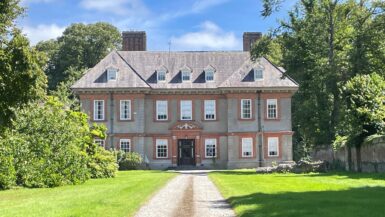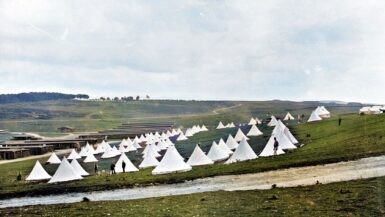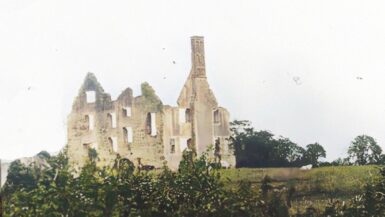CARLOW, a borough, market, and post town, a parish, and the head of a union, in the barony and county of Car low, and province of Leinster, 18 miles (N. E.) from Kilkenny, and 39 (S. W. by S.) from Dublin; containing 9901 inhabitants, of whom 8734 are in the borough: the parliamentary limits include the suburb of Graigue, in the barony of Slieumargne, Queen’s county, and contain altogether 10,409 inhabitants. This town, called till within a comparatively recent period Catherlough, or Catherlagh, is supposed to have derived that name, signifying in the Irish language “the city on the lake,” from its proximity to a large sheet of water which formerly existed here. The erection of the castle has been variously attributed to Eva, daughter of Dermot Mac Murrough; to Isabel, daughter of Strongbow; and to King John; but with more probability to Hugh de Lacy, about the year 1180. In the reign of Edward EL, the castle belonged to the crown, and was made the head-quarters of the seneschalship of the counties of Carlow and Kildare, instituted on account of the disturbed state of those districts. About the year 1361, Lionel, Duke of Clarence, established the exchequer of the kingdom at this place, and expended £500 in fortifying the town with walls, of which at present there is not a vestige. James Fitzgerald, brother of the Earl of Kildare, seized the castle in 1494; but it was soon afterwards invested by the lord-deputy, Sir Edward Poynings, to whom, after a siege of ten days, it was surrendered. In 1534 it was taken by Lord Thomas Fitzgerald, during his insurrection; and in 1577 the town was assaulted by Rory Oge O’More. James I. granted the manor to Donogh, Earl of Thomond, whom he also made constable of the castle. In 1641, the whole county was over-run by the insurgents, and the castle of Carlow was invested by a strong party, and reduced to great extremity, a number of Protestants had taken refuge within its walls, and the garrison was about to surrender, when it was relieved by a detachment of the Earl of Or’monde’s forces under the command of Sir Patrick Wemys. On his approach the insurgents raised the siege, and, after burning the town, took flight, but 50 of them were killed in the pursuit. This place was still constantly exposed to the assaults of the insurgents; and the castle, after sustaining a siege for nearly a month, ultimately surrendered in May, 1647. It was, in 1650, closely invested by Ireton and the republican army; and after a severe cannonade which greatly injured the castle, the garrison surrendered on conditions to Sir Hardress Waller, whom Ireton had left to conduct the siege. After the battle of the Boyne, in 1690, William III. led his army southward through this town; and during the disturbances of 1798, it was assaulted by the insurgents on the morning of the 95th of May. The garrison, consisting partly of regular troops and partly of yeomanry, amounting in the whole to 450, repulsed the assailants, though 2000 in number, with the loss of 600 of their men; on which occasion the loyalists were obliged to burn several of the houses, in order to compel the insurgents to abandon them.
The TOWN is pleasantly and advantageously situated on the eastern bank of the river Barrow, over which is a bridge of four arches connecting it with the extensive suburban village of Graigue: the whole is surrounded by a rich agricultural district, and sheltered by some ranges of hills well cultivated to their summits. It is of considerable extent, and contains more than fourteen good streets: the two principals, intersecting each other at right angles, and continued through its whole length and breadth, divide the town into four nearly equal portions, which are again divided and subdivided by smaller streets into 42 portions; having in the whole, 1355 houses. The town is rapidly increasing in all directions; and a new street, chiefly for private residence, is. now in progress, which, when completed, will be one of its greatest ornaments. Though a place of such high antiquity, it has an air of modem neatness: the streets are paved and kept in repair by county presentments, the two principals by the county at large, and the others by the barony in which the town is situated; and the inhabitants are supplied with water from public pumps. On the south side of the town is a stream called the Burren, which flows into the Barrow; and on a rising ground above its influx are the stately remains of the ancient castle, towering to a height of 60 feet above the roofs of the houses. There are two subscription reading-rooms; and to the south-east of the town are cavalry barracks for 8 officers and 112 non-commissioned officers and privates, with stabling for 90 horses, and an hospital for 20 patients.
From its advantageous situation on the Barrow, affording a facility of communication with the ports of Boss, Waterford, and Dublin, Carlow has become the principal mart for the agricultural produce of the well-cultivated districts around it, and carries on an extensive trade in corn and butter. the latter is of a very superior quality, and meets with a ready sale in the London market. The trade down the river has, within the last 14 years, greatly increased; while that upwards has diminished, in consequence of the heavy tolls demanded on the canal conveyance to the metropolis. The quantity of com and flour sent hence to Waterford and other ports for exportation has, within a few years, advanced from 3000 to 15,000 quarters; and the quantity of butter weighed in the market and in private stores is at present not less than 35,000 firkins. The river is navigable from Athy, where the Grand Canal from Dublin joins it, to its confluence with the Suir below Waterford. Boats consequently pass from this place to Dublin. Ross, and Waterford; there is a lock on the river, and good quays have been constructed for the accommodation of vessels employed in the trade. The Dublin and Cork line of railway has a branch to Carlow, passing near Athy. Carlow is the bead-quarters of the southern district of the revenue police, and sub-stations are fixed at Newtownbarry, Freshford, and Gore’s-bridge: there is also a chief constabulary police station in the town. Branches of the Bank of Ireland, the Provincial Bank, and the Tipperary Joint-Stock Bank, have been established. In the excise arrangements the town is within the district of Kilkenny. The market-days are Monday and Thursday, and fairs are held on May 4th, June 22nd, Aug. 26tb, and Nov. 8th.
The earliest charter on record relating to the BOROUGH is that of William Marshall, Earl of Pembroke, granted about the close of the 13th century. It created an open community of burgesses endowed with considerable privileges, including a guild mercatory and other guilds, with exemption from tolls and customs throughout the earl’s whole lands, except the towns of Pembroke and Wexford; it also mentions a hundred court as being then in existence in the town, and ordained that it should be held only once in the week. James I., in 1613, granted a charter of incorporation, conferring, among other privileges, a right to return two members to parliament; the late governing charter was obtained on petition from Charles II., in 1674. James II. granted a charter founded on a seizure of the franchises by a decree of the exchequer; but it soon became inoperative. Under the charter of Charles II. the corporation, previously to its late dissolution, was styled “The Sovereign, Free Burgesses, and Commonalty of the Borough of Catherlagh;” and consisted of a sovereign, twelve free burgesses, and a commonalty, assisted by a town-clerk, two serjeants-at-mace, a weighmaster of butter, and a bellman. The sovereign was annually elected by the sovereign for the time being and a majority of the burgesses from their own body, on the 24th of June, and entered upon his office on the 29th of September; he was ex officio a justice of the peace for the borough and the county, and clerk of the market, and with the approbation of the burgesses could appoint one of them to be his deputy. The burgesses were elected from the freemen by a majority of the sovereign and burgesses; the town-clerk and serjeants-at-mace were chosen by the sovereign and burgesses, and the weighmaster of butter was appointed by the sovereign. The freemen were elected by the sovereign and burgesses. The corporation continued to exercise all its rights and privileges until the passing of the act 3rd and 4th of Victoria, cap. 108, when it was dissolved, and its property became vested in a board called the “Municipal Commissioners.”
The borough returned two members to the Irish parliament till the Union, since which period it has sent only one to the Imperial parliament. The right of election, previously confined to the sovereign and burgesses, was, by the act of the 2nd of William IV. for amending the representation, extended to the resident freemen and £10 householders: the constituency on the register, and qualified to vote, is 565, of whom 556 are £10 householders, and 9 burgesses; the high sheriff is now the returning officer. By the charter, the corporation had power to hold a court of record for pleas to the amount of five marks; but they latterly exercised no jurisdiction whatever, either civil or criminal. The assizes, and also the quarter-sessions for the county, are held here; and petty-sessions are held every Thursday before the county magistrates. The manor court has jurisdiction to the amount of £10 late currency over the entire town and an extensive rural district: it had fallen into disuse prior to 1833, when the lord of the manor, B. Hamilton, Esq., appointed a seneschal, and the court was revived; but few cases have been since determined in it. The court-house, a newly-erected building at the junction of the Castledermot and Athy roads, near the entrance of the town, is a handsome octagonal edifice, with a fine Doric portico in imitation of the Acropolis at Athens, resting upon a platform to which is an ascent by a broad flight of steps, the whole is of hewn granite, of chaste design and execution, and forms a striking ornament to the town. Near it is the county gaol, which, exclusively of the female and the debtors’ prisons, contains 26 cells, with seven small rooms, in the old building, and 20 cells in the new; the prisoners are engaged in useful labour, and are taught trades, to qualify them on their discharge for a life of industry. The female prisoners are also carefully instructed, and employed under a duly qualified matron; a school has been established, and the sick are attended by a medical officer. There is a tread-wheel, worked for raising water to supply the gaol.
The PARISH comprises 3330 statute acres, of which about 648 are plantations, a few acres bog, and the remainder good arable and pasture land. The surrounding scenery is pleasingly varied, and in many parts beautifully picturesque: there are several handsome seats. Oak Park, formerly called Paynestown, is a spacious building consisting of a centre and two wings, situated to the north of the town, in a fine demesne embellished with stately groves of full-grown oak. To the east of it are Browne 11 Hill and Viewmount House, the latter formerly the seat of Sir E. Crosbie, Bart., and commanding a beautiful prospect of the neighbouring country. On the opposite side of the river, below the town, is Cloghgrenan, situated in a highly improved demesne. The living is a rectory, in the diocese of Leighlin, and in the patronage of the Crown for two presentations, and of the Bishop for one: the tithe rentcharge is £225. The church is a modern structure, with a beautiful spire terminating at an elevation of 195 feet, and having a massive gilt cross presented by the ladies of Carlow: the Ecclesiastical Commissioners lately granted £488 for repairs. Near the river, to the north of the town, is an ancient burial-ground called “The Graves,” said to have been granted to the parish by the Earl of Thomond. There is no glebe-house; the glebe comprises 2 acres. The Roman Catholic parish is co-extensive with that of the Established Church, and is the benefice of the Bishop of Kildare and Leighlin. The Roman Catholic cathedral is an elegant cruciform structure in the later English style, with a lofty tower at the western extremity of the nave, surmounted by a lantern of beautiful design terminating at a height of 151 feet from the base; it occupies the site of the old chapel, and is a rich ornament to the town. At the foot of the altar are interred the remains of the Right Rev. Dr. James Doyle, late bishop, distinguished by his letters under the signature of J. K. L., and by his important evidence before both houses of parliament. He entered the college of Carlow, as professor of rhetoric, in 1811, and was soon after-wards appointed professor of theology; he was raised, in 1819, to the Roman Catholic see of Kildare and Leighlin, and died of a lingering decline on the 10th of June, 1834. Braganza House, the residence of the bishop, is in the immediate vicinity of the town. There are places of worship for Presbyterians, the Society of Friends, and Wesleyan Methodists.
The College of St. Patrick, for the education of youth and of the Roman Catholic clergy, was founded by the Rev. Dr. Keefe, and opened in the year 1795 under the direction of Dean Staunton. The system of education comprises the Hebrew, Greek, Latin, Italian, French, and English languages, sacred and profane history, rhetoric, geography, arithmetic, and the mathematics, to which are added natural and moral philosophy, humanity, and theology; the whole under the superintendence of professors and assistants, who are members of the house and resident The building, which consists of a spacious centre connected with two wings by corridors, is situated in a park comprising an area of 34 acres nearly in the centre of the town, enclosed with high walls, and well planted, affording ample opportunities of healthful recreation and undisturbed retirement. The institution is under the direction of a president, vice-president, and prefect, of the lay college, a dean of the ecclesiastical college, and other officers; the fees are £31. 10. per annum for lay, and £27 for ecclesiastical, students. Connected with it is a neat chapel having a burial-ground attached. A convent of the Presentation order was established in 1814, consisting of a superior and 16 nuns, who gratuitously instruct about £250 children; it is a handsome edifice in Tullow-street. A branch from the Sisters of Mercy in Baggot-street, Dublin, was formed here in 1837. The Diocesan School of Leighlin and Ossory is supported by the bishop and the clergy, the bishop paying one-third of the master’s salary. The District Lunatic Asylum for the counties of Carlow, Kilkenny, Wexford, and Kildare, and the county of the city of Kilkenny, is situated in this town, and was built in 1831, at an expense, including the cost of erection and purchase of land and furniture, of £22,552. 10.; it is under excellent regulation, and attached to it are 15 acres of land. From the time of its opening to the 31st of March 1841, 445 patients were admitted, of whom 213 recovered and were discharged, 20 were discharged relieved, and 54 died; 158 remained in the asylum, whereof 20 were relapsed cases. The expenditure of the year ending on the above day was £2451: in 1844 the expenditure was £2319. The county infirmary is supported by grand jury presentments and local subscriptions, aided by a parliamentary grant; a fever hospital, opened for the reception of patients in 1829, is supported by grand jury presentments alone: a dispensary is maintained in the usual way, and a Magdalene asylum wholly by subscription. The workhouse, on a site of 7 acres purchased for £1000, was completed in 1842, at a cost of £9000, and is constructed to admit 800 paupers.
The remains of the old castle consist of one side of the quadrangle, at each end of which is one of the massive round towers that flanked its angles: the walls shew that it must have been a fortress of much strength; and from the loftiness of its elevation and the commanding position which it occupies, it has still a striking appearance of majestic grandeur. Near Oak Park was a small Franciscan friary, founded by the Cooke family, formerly proprietors of that estate. Browne Hill and Viewmount occupy the site of an ancient religious establishment, called St. Kieran’s Abbey; and in the vicinity are the remains of a cromlech, the table-atone of which is 23 feet in length, 19 in breadth, and at the upper end nearly 4 feet thick; it is supported at the east end on three upright stones, 15 feet 8 inches high, and at a distance is another upright stone standing by itself. Carlow gives the inferior title of Viscount to the family of Dawson, earls of Portarlington.
Extract from: Lewis – A Topographical Dictionary of Ireland





Leave a reply